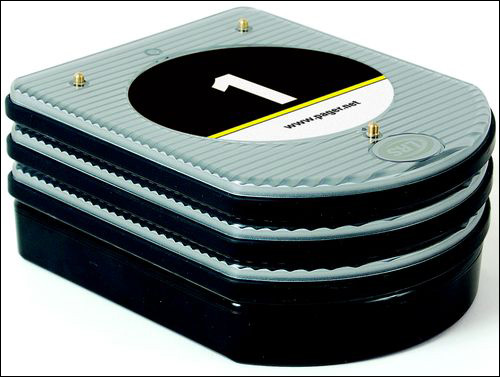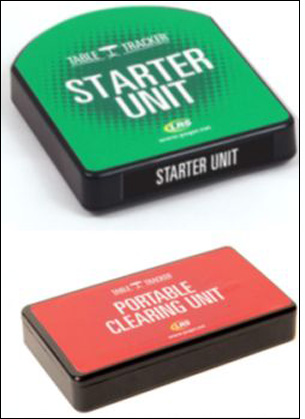After a customer orders food at the counter and takes a seat at one of Blue Lemon‘s three restaurants in Utah, the meal is now served faster, thanks to the use of radio frequency identification technology. Prior to installing the Long Range Systems (LRS) technology, the staff had to walk throughout the busy restaurant carrying plates of food, searching for numbers on tables identifying specific customers’ orders. Now, they can simply view a screen near the kitchen, determine the location of the table at which the customers are seated, and proceed directly to that spot.
The faster service is made possible by high-frequency (HF) RFID tags attached to the underside of each dining table, as well as Table Trackers—devices that read the tags and communicate with a gateway via ZigBee technology. Table Tracker software not only stores the table location and interprets read data from each Table Tracker device, but also tracks the amount of time that passes after the order was placed, and can warn workers and management in the event that the length of a wait is approaching, or has reached, an unacceptable limit.
Since the system was installed at the company’s three restaurants in June, says Aaron Day, Blue Lemon’s CEO, the amount of time required for a plate to be delivered to a table has been reduced by between one and five minutes. For customers, Day says, that means the food arrives faster, and is hot and fresh. That customer satisfaction, he adds, has already made the technology pay for itself during the six months that it has been in use.
Prior to Blue Lemon’s adoption of the Table Tracker system, each patron or party was given a number placard to place on their table, and when trying to delivering plates of food to table, staff members sometimes had to call out orders in the hope that the appropriate diners would recognize and claim their meals. While this was taking place, Day says, the food was cooling and labor time was wasted.
Blue Lemon serves artisan sandwiches, salads and gourmet entrees, and considers it a priority to serve this food on time. Last year, the firm decided to invest in technology from LRS. It required a solution for all three of its establishments, especially in downtown Salt Lake City, where business is busy and table space is at a premium. That restaurant alone completed $4 million in sales last week, Blue Lemon reports, while the company serves 2,000 customers weekly at all three locations.
LRS has been offering solutions to help employees identify customer tables for several years, according to Jeff Jones, LRS’ director of sales. Approximately eight years ago, he says, the company noticed a trend among food-service businesses toward the fast casual restaurant model, as opposed to casual restaurants in which the wait staff take orders at a diner’s table. As more such restaurants have been established, he says, there has been an increasing need for a solution to the question, “Whose order is this?” Restaurants often simply must hire additional workers to locate tables and deliver orders.
Several years ago, LRS developed a system known as Key Call, in which each diner carried a key that he or she was instructed to place within a battery-powered ZigBee or ultrahigh-frequency (UHF) RFID reader installed at that person’s table. Upon selecting a table, the patron inserted a key into a device that began transmitting that key’s unique ID number to a receiver. Ultimately, that information was then displayed on a computer screen located within the kitchen. The shortcoming, the company explains, was that it required an action on the diner’s part, and so LRS developed the Table Tracker system to only require the diner to take the Table Tracker to the table and await the meal’s delivery.
Here’s how the system works: When a party of diners first place their order, a staff person enters that order into the point-of-sale system. The worker also inputs an ID number, such as 27, that is then printed on the top of the Table Tracker—which is slightly smaller than, but similarly shaped to, a CD in its plastic cover. Employees then wave the Table Tracker over a Starter Unit—a small, green box containing an RFID tag and mounted on the counter. The Table Tracker’s built-in RFID interrogator reads the Starter Unit’s tag, initiating a timer function. The customer then carries the Table Tracker into the dining area, selects a table and places the device on that table.
Pasted to the table’s underside are two dozen or so 13.56 MHz passive HF RFID tags compliant with the ISO 15693 standard. On average, about 20 tags are glued to each table’s underside, in order to guarantee a read no matter where on the table the Table Tracker is placed. Each tag ID number is linked, in the LRS software, to a specific table within the dining room. When the Table Tracker reads one of the table’s tags, it transmits that ID number via ZigBee to a gateway plugged into a computer running the LRS standalone software.
When the order is ready to serve, a staff member views the computer screen to pinpoint the Table Tracker ID associated with that particular order, and sees the table at which the customer is seated. The worker then simply delivers the food to that location. Each staff member also carries a pocketsize Clearing Unit, which, like the Starter Unit, has its own embedded RFID tag. After the plates have been delivered to the table, the employee places the tracker near the clearing unit, and the tracker stops the timing process, thereby indicating to the LRS software that the food has been delivered. The Table Tracker is then placed on a charging station to recharge its battery.
The LRS software not only allows management to track how long it takes to prepare and deliver an ordered meal to customers for the purpose of business analytics, but can also provider an alerting function. Each order is displayed on the screen by the LRS software, along with the ID number, and that information will turn yellow or red, based on the amount of time that has passed if an order has not been delivered. This helps the staff to prioritize their work.
For management, the historic data allows them to view average delivery times; assess which shifts, workers or other variables might be negatively affecting those times; and then address any problems that might exist. For example, if a specific shift experienced a slower rate of preparing and serving food, management could determine that additional staff members were necessary at that time.
LRS manufactures all of its own hardware, Jones says, with the exception of the RFID tags.
Jones estimates that between 50 and 100 restaurants around the world are presently using the Table Tracker technology, including three that are part of the 240-store Jason’s Deli chain, owned by Deli Management Inc., of Beaumont, Texas. In one case, he recalls, a business was reluctant to invest in an automated solution to food delivery, until the company’s board met over lunch at one of its own restaurants, down the street from its headquarters. Jones says the firm’s board chair was repeatedly asked by servers, “Are you sure this isn’t your chicken panini?” That experience, he adds, convinced the board to try the Table Tracker system.
According to Day, Blue Lemon has already seen a return on its approximately $8,000 to $10,000 investment per restaurant, based on the reduced time that staff members spend searching for tables. However, he says, the greatest gains involve customer satisfaction, since diners are assured that they will receive their food quickly—and fresh—from the kitchen. “We’ve had our return just in satisfaction,” he states. “I know the food is getting delivered hot.”




